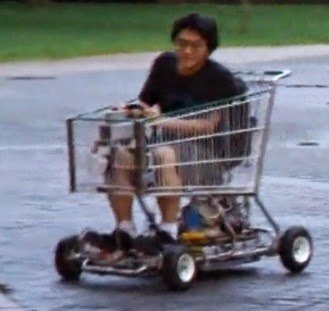 |
| Electric Arduino Go-kart (from Instructables) |
And...the go-kart will make your Arduino go pretty fast. In MPH, not GHz.
I first saw this go-kart mentioned on Google News in the Unocero article "Un Go-Cart eléctrico que usa Arduino," so if your native language is Spanish, you may want to read that version of this tech story. Google News is nice that way, because sometimes I see a non-English article that lets me know about a story Id not have read if it wasnt in English. Google Translate certainly is not perfect or even almost perfect, but it usually gives a usable version of the article, and you can do more Googling based on the Skynet-translated version of a non-native language article.
 |
| Steering wheel showing LCD screen (from Instructables) |
It appears the source of the story about this Kartduino is the "Electric Arduino Go-kart" Instructable done by a 15-year old from California. The Instructables write-up presents some of the technology used to build the go-kart, but it cautions the reader that its not a complete guide to building the vehicle. Heres a taste of the write-up:
"The drive setup uses a Hobbywing Xerun 150A brushless electronic speed controller to control a Savox BSM5065 450Kv motor. Batteries are 3x zippy lithium polymer - 5 cells, 5000mah. The motor has two large fans I pulled out of an old computer for cooling, mounted right over the motor. The chain drive is a 1:10 overall ratio, using a 15 tooth on the motor chained to a 30 tooth on the jackshaft, and a 9 tooth from the jackshaft to a 45 tooth on the wheel. The tires are 10" diameter so at 20 volts the top speed is around 30 mph. The ESC is controlled via PWM from the arduino. A throttle potentiometer on the steering wheel controls this. Constant current is around 40-50A, and the batteries last around 30 minutes with an average speed of 10-15mph. It requires a small push to get started (really, the motor just has to be rotating) and accelerates extremely fast...This uses a sensorless brushless motor. They are not capable of starting under load. It may need a quick push before it can start. Dont try to start them under load. I already had one motor burn out because it stalled and the current burnt the coils insulation. Sensored motors overcome this problem."Im sure if the Humboldt Microcontrollers Group ever wanted to build a similar kartduino, Ed and others in the group would have plenty of ideas and knowledge on how to improve the design, with sensored motors or an alternate solution to the sensorless brushless motors that burned out on the design shown in the Instructables.
 |
| Go-karts wooden electronics control box (from Instructables) |
With regards to the MCU in this zippy little go-kart, the Hackaday post covers the different parts of the vehicle integrated with the Arduino.
"In addition to the throttle control, the Arduino is also responsible for other operational aspects of the vehicle. There are a bunch of LED lights that serve as headlights, tail lights, turn signals, brake lights and even one for a backup light. You may be wondering why an Arduino should be used to control something as simple as brake or headlights. [InverseCube] has programmed in some logic in the code that keeps the break lights on if the ESC brake function is enabled, if the throttle is below neutral or if the ESC enable switch is off. The headlights have 3 brightnesses, all controlled via PWM signal provided by the microcontroller. There is also an LCD display mounted to the center of the steering wheel. This too is controlled by the Arduino and displays the throttle value, status of the lights and the voltage of the battery."An interesting alternative kartduino I ran across whilst doing research for this post is the
 |
| LOLrioKart (by MIT student) |
Speaking of modern vehicles and the increasingly important roles played by MCUs in vehicles, maybe Ford, another vehicle manufacturer, a microcontroller manufacturer or an electronics distributor will in the future want to sponsor a Humboldt Microcontrollers Group project to design and build a modified version of Steve Salzmans vehicle, with upgrades that allow it to parallel park itself as well as generate and track all sorts of vehicle operation data. That will be a fun project!
**********